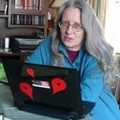Features
net.wars: Many hidden returns
by Wendy M Grossman | posted on 22 June 2007
This week, the Open Rights Group released its report on the May 7 electronic voting pilots, conducted during by-elections in various locations in England and across all of Scotland. ORG observed these as closely as it could through the eyes of 25 volunteers.

Much of the report should be familiar to anyone who's read about similar trials and pilot projects in the US and elsewhere (especially the UK's own 2003 trials). There were technical problems when equipment failed or had to be rebooted. There were people problems, when both voters and officials were uncertain how to make machines work. There were security issues, as when ORG observers found PCs and switches with open ports and no one watching them. And there were design problems, when ballot layouts confused voters into spoiling ballots. Sound familiar?
More than that, the process of tallying votes just isn't transparent. At some point in the process, a miracle occurred and numbers were produced. Anti-evoting activists have been talking about "black box voting" for years, and here it was, live and in the silicon. Probably no one expected ORG to come away from the trials glowing with enthusiasm about the technology. But the group put a significant amount of effort into observing the process and reporting fairly what it saw. The report needs to be taken seriously by the people in charge of choosing how we vote.
The job for the observers, from the sounds of it, wasn't easy. Rules were inconsistent, inconsistently applied, and subject to abrupt change. My favourite was the constituency that apparently got its security advice from someone used to working with banks: they were told not to let anyone see the screens of the laptops. But the whole point of elections is to make the process publicly accountable – which means the nuts and bolts need to be visible.
Curiously enough, it may be the black-box nature of these systems that kills them after all, just not for the reason we always thought.
If there is one consistent refrain throughout the mad rush to move ballot boxes inside computers it's that new technology will engage a new generation of currently disaffected voters. One of the most intriguing observations to come out of the Open Rights Group's report on the recent e-voting trials, therefore, is: "People passionate about local politics were consistently being turned off by the e-voting and e-counting pilot counts in areas observed" (p20).
People who don't care that much may just want the counts. But if you're a politician running for office, his agent, or one of the dozens (or thousands) of people who participated in the political process by campaigning for him or who cares about specific issues, just getting the count out of a black box is as much missing the point as watching a tennis match by looking up the final score on the Internet.
Worse, since what's at stake is who runs the country (rather an Oscar or a trophy), you need to have confidence that the count has some relation to how people actually voted. If I lived in any of the constituencies where these pilots took place, I'd be demanding they re-run the election.
That might be the thing that kills it, more than the security problems or any philosophical problem the general public might have with privatizing voting. Without passionate supporters there would be no candidates
Politics, sports, and entertainment all face the same challenge of engaging fans. The lesson from sports in particular is that the more detail you give fans the more obsessive they become. If there were some way to project each ballot, one at a time, on a giant screen, without destroying the secrecy of individual ballots, maybe every election would have the magnetic quality of Bush vs. Gore 2000. It would be quite a show, especially if people had the option of standing up at a microphone and explaining just why they voted the way they did. How's that for public access TV?
As things were, electronic counting meant agents, candidates, and various others couldn't tell what was going on. Internet voters can't be interviewed on existing the poll station, so local parties can't get a sense of how the vote is going. The campaigners who show up on people's doorsteps to get out the vote don't know whose doorsteps to canvass.
This may not seem like much of a loss. But, as ORG points out, one way candidates have traditionally decided whether to ask for a recount is by comparing the posted returns with the information the parties have worked to compile throughout the day. (For US voters: after you exit UK polling areas you typically find party representatives conducting exit polls.)
I'm not convinced that the end users – that is, the voters – count for much in any of this. So far, the best efforts of computer scientists, hackers, and activists have had little success in trying to turn back the clock to pencil and paper or other forms of tried and trusted technology.
But if the insiders don't like it – the politicians who award funds, the parties who elect them – there might just be a chance it won't fly permanently. If so, they'd better act now, before the vendors become big enough to own us all.
Technorati tags: voting
Too few votes cast? - You can discuss this article on our discussion board.
Wendy M. Grossman’s Web site has an extensive archive of her books, articles, and music, and an archive of all the earlier columns in this series. Readers are welcome to post here, at net.wars home, follow on Twitter or send email to netwars(at) skeptic.demon.co.uk (but please turn off HTML).
in Features
net.wars: In search of the very, very small
you're reading:
net.wars: Many hidden returns
Muggles penetrate Harry Potter And The Pedant Of CIX


